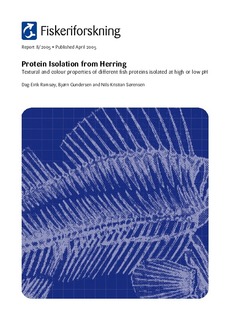| dc.contributor.author | Ramsøy, Dag-Eirik | |
| dc.contributor.author | Gundersen, Bjørn | |
| dc.contributor.author | Sørensen, Nils Kristian | |
| dc.date.accessioned | 2018-12-10T08:26:36Z | |
| dc.date.available | 2018-12-10T08:26:36Z | |
| dc.date.created | 2015-04-23T15:10:34Z | |
| dc.date.issued | 2005 | |
| dc.identifier.isbn | 82-7251-556-3 | |
| dc.identifier.uri | http://hdl.handle.net/11250/2576752 | |
| dc.description.abstract | Fiskeriforskning has been partner in a project financed by industry and the Nordic Innovation Centre, with the aim to scale up a laboratory method for producing functional fish protein isolates. The pilot plant was located in Iceland and four Nordic countries participated, representing four research institutes and three industry companies. The choice of extraction method, acid or alkali, is essential for the quality of the FPI. The extraction methods give significant different results regarding all parameters assessed, except for true strain. Texture values were generally higher in alkali samples than acid samples. The sensory analysis gave a preference to alkali treatment regarding textural properties, while the acid treatment seemed to result in better colour and less rancid odour and taste. Addition of phosphates (TSPP) gave a significant difference in all parameters except for shear stress. The differences resulted in higher texture values and lower scores on all colour characteristics. Both Trehalose and Raftilose®P95 seem to have at least as good capacities as sorbitol and sucrose, to be used as cryoprotectants. When comparing the two extraction methods within the same cryoprotectant group, the alkali treated samples scored higher in rancid odour with exception of sorbitol samples. Optimum pH for good texture properties was found to be around pH 7,1. A negative effect of increased pH is a decrease in colour values. Decreasing b*-values did not outweigh the reduced L*-values. Addition of soy protein isolate had no or rather negative effect on all parameters. Samples containing soy protein seem to be less affected to pH changes. The dried samples had an intense rancid odour, with a dark yellowish or grey colour. The re-hydrated protein isolate samples did not produce a proper gel, and did not hold water very well. Rehydration time and homogeneity of the dried samples depended on granule size. | |
| dc.description.abstract | Protein Isolation from Herring – Textural and colour properties of different fish proteins isolated at high or low pH | |
| dc.language.iso | eng | |
| dc.publisher | Nofima AS (tidligere Fiskeriforskning) | |
| dc.relation.ispartof | Nofima rapportserie | |
| dc.relation.ispartofseries | Nofima rapportserie | |
| dc.relation.uri | https://nofimaas.sharepoint.com/sites/public/_layouts/15/guestaccess.aspx?guestaccesstoken=zxQwepON0RbAPJR6K%2fkBNMQOD97Fs37%2fxRNc%2fj38oJQ%3d&docid=0be7604755df04d67b9891eadeec85965 | |
| dc.title | Protein Isolation from Herring – Textural and colour properties of different fish proteins isolated at high or low pH | |
| dc.title.alternative | Protein Isolation from Herring – Textural and colour properties of different fish proteins isolated at high or low pH | |
| dc.type | Research report | |
| dc.description.version | publishedVersion | |
| dc.source.pagenumber | 34 | |
| dc.source.issue | 8/2005 | |
| dc.identifier.cristin | 1238777 | |
| dc.relation.project | Andre: P-00075 | |
| dc.relation.project | Nofima AS: 8544 | |
| cristin.unitcode | 7543,2,5,0 | |
| cristin.unitname | Sjømatindustri | |
| cristin.ispublished | true | |
| cristin.fulltext | original | |
